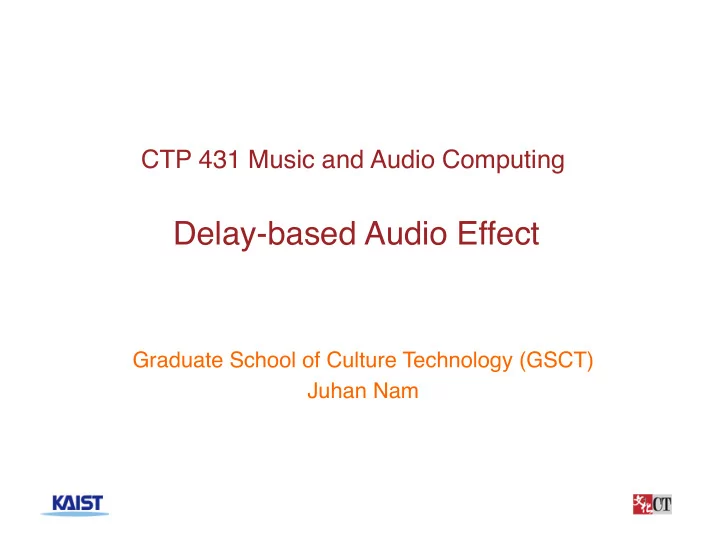

CTP 431 Music and Audio Computing Delay-based Audio Effect Graduate School of Culture Technology (GSCT) Juhan Nam 1
Introduction § Types of delay-based audio effect – Delay – Chorus – Flanger – Reverberation 2
Perception of Time Delay § The 30 Hz transition – Given repeated click sound (e.g. impulse train): • If the rate is less than 30Hz, they are perceived as discrete events. • As the rate is above 30 Hz, they are perceive as a tone – Demo: http://auditoryneuroscience.com/?q=pitch/click_train § Feedback comb filter: y(n) = x(n) + r y(n-M) – Models sound propagation and reflection with energy loss – If M < fs/30: generate a tone • E.g. Karplus-strong model of tone generation ( https://en.wikipedia.org/wiki/Karplus%E2%80%93Strong_string_synthesis) – If M > fs/30: generate a looped delay • E.g. Delay effect 3
Delay + x(n) Delay Line feedback Wet Dry y(n) + § Delay effect – Generate repetitive loop delay – Feedback coefficient controls the amount of delayed input – Can be extended to stereo signals such that the delay output is “ping-ponged” between the left and right channels – The delay length is often synchronized with music tempo – The delayline is implemented as a “circular buffer” 4
Chorus LFOs Delay Line x(n) + Wet Dry y(n) + • Chorus effect – Gives the illusion of mul?ple voices playing in unison – By summing detuned copies of the input – Low frequency oscillators are used to modulate the posi?on of output tops à This causes the pitch of the input (resampling!) 5
Flanger LFOs Delay Line x(n) Sta?c tap Variable tap + Wet Dry y(n) + • Flanger effect – Originally generated by summing the output of two un-locked tape machines while varying their sync (used to be called “reel-flanging”) – Emulated by summing one sta?c tap and variable tap in the delay line • Feed-forward combine filter where harmonic notches vary over frequency. – LFO is oPen synchronized with music tempo 6
Reverberation Listener Direct sound Sound Source Reflected sound § Natural acoustic phenomenon that occurs when sound sources are played in a room – Thousands of echoes are generated as sound sources are reflected against wall, ceiling and floors – Reflected sounds are delayed, attenuated and low-pass filtered: high-frequency component decay faster – The patterns of myriads of echoes are determined by the volume and geometry of room and materials on the surfaces 7
Reverberation § Room reverberation is characterized by its impulse response (IR) – E.g. when a balloon pop is used as a sound source CCRMA Lobby Impulse Response 1 • The room IR is composed of three parts 0.8 – Direct path 0.6 – Early reflec?ons direct path response amplitude – Late-field reverbera?on: high 0.4 early reflections echo density 0.2 • RT60 0 – The ?me that it takes the reverbera?on to decay by 60 dB -0.2 late-field reverberation from its peak amplitude -0.4 0 10 20 30 40 50 60 70 80 90 100 time - milliseconds 8
Artificial Reverberation § Mechanical reverb – Use metal plate and spring – Plate reverb: https://www.youtube.com/watch?v=XJ5OFpvX5Vs § Delayline-based reverb – Early reflections: feed-forward delayline – Late-field reverb: allpass/comb filter, feedback delay networks (FDN) – “Programmable” reverberation § Convolution reverb – Measure the impulse response of a room – Do convolution input with the measured IR 9
Delay-based Reverb _ y(n) x(n) + + Z -M - A reverb is constructed by cascading mul?ple AP or FFCF units AllPass filter / Comb filter (when one tap is absent) Z -M1 x(n) y(n) + + Z -M2 Z -M3 - The lengths of delaylines are chosen such that their greatest common factors a 11 a 12 a 13 is small (e.g. prime numbers) a 11 a 12 a 13 a 11 a 12 a 13 - The mixing matrix is chosen to be unitary (orthonormal) Feedback Delay Networks 10
Convolution Reverb § Measuring impulse responses measurement noise n (t) r (t) s (t) r ( t ) = s ( t ) ∗ h ( t ) + n ( t ) , h (t) test LTI measured sequence system response – If the input is a unit impulse, SNR is low – Instead, we use specially designed input signals • Golay code, allpass chirp or sine sweep: their magnitude responses are all flat but the signals are spread over time – The impulse response is obtained using its inverse signal or inverse discrete Fourier transform 11
Convolution Reverb sine sweep, s(t) sine sweep spectrogram 0.5 10 frequency - kHz amplitude s ( t ) 0 5 -0.5 0 0 500 1000 1500 0 200 400 600 800 1000 sine sweep response, r(t) sine sweep response spectrogram 1 10 frequency - kHz 0.5 amplitude r ( t ) 0 5 -0.5 -1 0 0 500 1000 1500 2000 0 500 1000 1500 2000 time - milliseconds time - milliseconds measured impulse response 0.08 0.06 0.04 ˆ amplitude h ( t ) 0.02 0 -0.02 ( J. Abel ) -0.04 0 100 200 300 400 500 600 700 800 900 1000 time - milliseconds 12
Recommend
More recommend